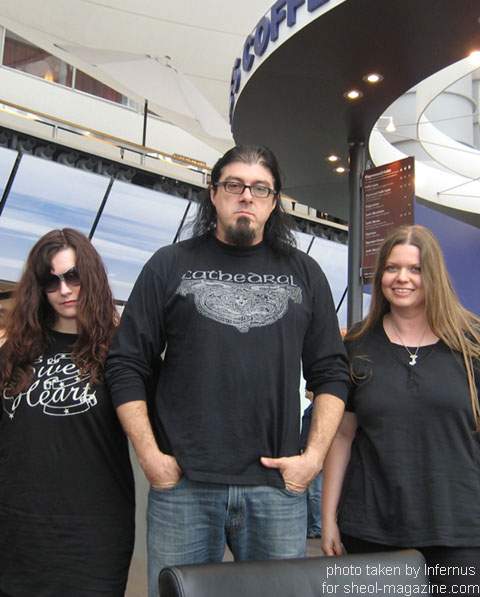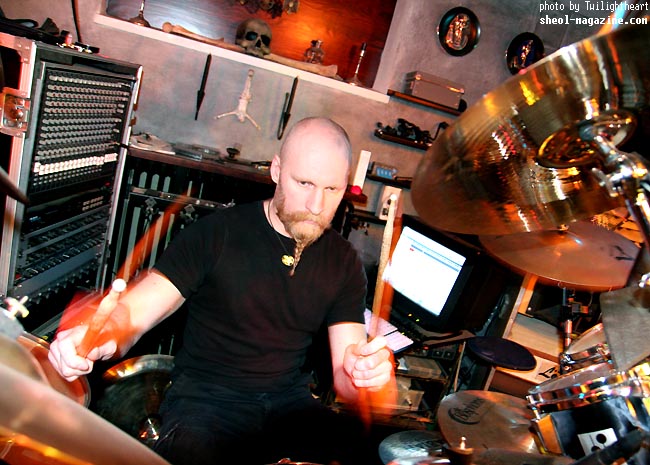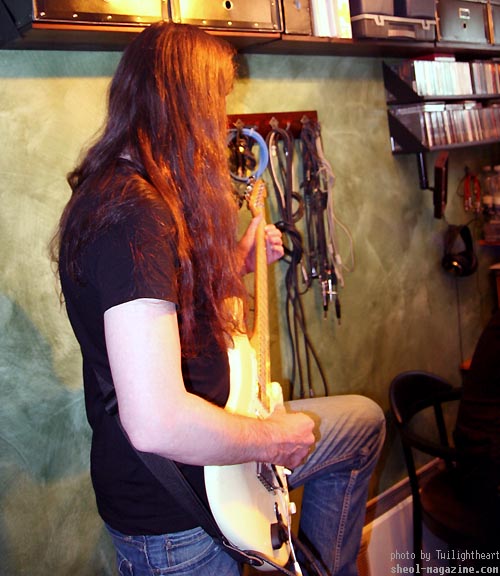|
At
the end of June 2009 several writers/Metal magazines received an
invitation from Gorgoroth to visit them in the studio whilst they were
working on their upcoming album "Quantos Possunt ad Satanitatem
Trahunt". I was quite amazed to be among the few lucky ones to be
invited (aside from Sheol, I will also write about this studio visit for
“Zero Tolerance”, Britain’s third biggest extreme music magazine). Infernus tried his talents as a photographer and took some souvenir photos of Claudia and myself with Frank.
After
Frank left we headed off to the parking area. Infernus behaved like a
gentleman and offered to take our bags before driving us to our youth
hostel (unlike Germany, there is no age limit for those staying in youth
hostels in Sweden). As the drive took about half an hour, we got our
first opportunity to listen to the rough mix of the new album on the
car’s audio systems (some parts without guitars yet, though). Claudia
was over the moon when she heared the new stuff. Pest’s voice and
excellent singing (even using clean vocals in short sections) especially
gave her the thrills. I, for my part, most liked the fact that the new
album does NOT (as I had feared before I heard it) follow on previous
band formations, but has its own great, fundamental Black Metal style
that’s immediately electrifying. As soon as the music was turned on (even
though it was not finished yet) an intense satanic aura seemed to spread,
and particularly the extremely heavy, massive mid-tempo tracks left an
instant impression on me, because in these Pest can unleash his complete
vocal range of growling, screaming and singing (in our last interview
Infernus said “Pest is angry as hell” … and believe me, you will
be able to hear that on the new album). Right after that we headed off to “Monolith” studios, which are Tomas Asklund’s private studios in the cellar of a house near Stockholm and whose address you probably won’t find in Google (and as I am quite sure the location is supposed to stay private, I will not reveal any details about it’s location here). Other bands cannot just rent this studio for their recordings, it’s Tomas’ own private “playground” only. He gets to decide who’s allowed to enter and who is not. Dissection’s Mini-CD was recorded here too, by the way. When we stepped into the two cellar rooms for the first time, my jaw dropped in amazement. Wherever I looked, I saw gigantic tour posters of Dissection, and in a corner of the recording room there was the huge Dissection-cross-symbol made from metal alloys (which was used on stage during the concerts). But of course there was also a mass of technical equipment. A “Dean Demonator” bass guitar was hanging on the wall and a gigantic “Sonor” drums & percussions set dominated the room. Later on during one of the breaks between the recording sessions,Tomas took the opportunity to play something on his drumset.
Now the computers and amplifiers were turned on to warm up for the guitar recording. Tomas uses the program “Cubase SX” which is among the better ones on the market. It is known for easy handling when smaller timing errors by the musicians must be corrected. The program is even so good that you could take a vocalist that can’t sing and you just let him SPEAK the lyrics, and later on with Cubase’s audio-engine you can add vibrato and pitches to make it sound like singing (and you wouldn’t be able to tell the difference). But hey, don’t worry! This was not an option during the recordings of Pest’s vocals. ;-) I know for sure that Pest was doing vocals the “old” way.
The drum recordings were done using sampling. Therefore Tomas had recorded all kinds of pitches (played by himself on his drum) in a very time-consuming session (only the bass drum was triggered). But
for today some more guitar recordings were planned. As the guitar
signals would be sent directly from the pickup to the recording program
(without microphone), any background noise would not affect the
recording and therefore we didn’t need to leave the room and could
join the musicians directly in the recording room.
After that there were several hours of just guitar recordings. The same parts were played again and again; sometimes just the intensity of one note was different from the take before. I wasn’t even able to tell why the last take was better than the first take for instance (although a difference was notable), but hey… I will definitely recognize these melodies later on when I listen to the finished album. It was impressive for me to see how much effort it takes to produce 10 minutes of music on the end product. Infernus
during the guitar recordings: As soon as some takes had been recorded, Tomas would edit them, adding the guitar tracks (called “regions”) to the vocal regions and to those of other intruments, starting a little mixdown to hear how the result might sound. When appropriate it was even decided to record some small sections in stereo (in this instance this meant the lead or rhythm guitar was recorded identically twice and then one would be mixed right and one left). Tomas
editing: I
was amazed how well they both worked as a team. There was the occasional
humorous banter, but most of the times it was hard work. Infernus
and Tomas listening to the results of the recordings & discussing it: However,
before we left we were able to listen to most parts of the album again.
There was one song called “Rebirth” which stuck firmly in my mind,
as it was so captivating. I even recognized it immediately when I heared
it again sometime later. I can’t wait to have the finished album in my
hands. The
last photo, taken before we left > Tomas and Claudia in the recording
room: As
this was Midsummer in Sweden, I couldn’t sleep at all. I went to bed
at midnight and it was daylight outside. I woke up at 3:30 in the
morning and it was daylight again. My inner sensors refused to allow me
to sleep when it was daylight outside, so I took the opportunity to take
some more photos outside, as there was some nice scenery behind the
youth hostel.
|



